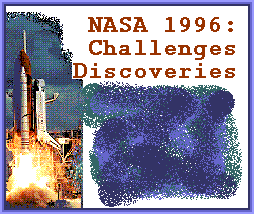 |
NASA 1996: A Year of Spectacular Discoveries and New Challenges |
| A rock, a record, a rover and a new rocket led NASA news stories in 1996. | |
|---|---|
 |
NASA 1996: A Year of Spectacular Discoveries and New Challenges |
| A rock, a record, a rover and a new rocket led NASA news stories in 1996. | |
|---|---|
"The evidence is exciting, even compelling, but not conclusive. It is a discovery that demands further scientific investigation. NASA is ready to assist the process of rigorous scientific investigation and lively scientific debate that will follow this discovery."Goldin invited governments from around the globe to participate in the continuing investigation of the meteorite.
